Border Crossing warning
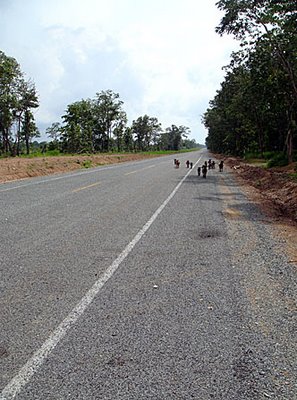 The empty highway, except for a family of goats, leading to the Laos-Cambodia border crossing at Dong Kralor
The empty highway, except for a family of goats, leading to the Laos-Cambodia border crossing at Dong KralorCambodia - Temples, Books, Films and ruminations...
 The empty highway, except for a family of goats, leading to the Laos-Cambodia border crossing at Dong Kralor
The empty highway, except for a family of goats, leading to the Laos-Cambodia border crossing at Dong Kralor Am I trying to fly or kayak, no-one was quite sure. This is at the end of our 3-hour kayak session in Luang Namtha
Am I trying to fly or kayak, no-one was quite sure. This is at the end of our 3-hour kayak session in Luang Namtha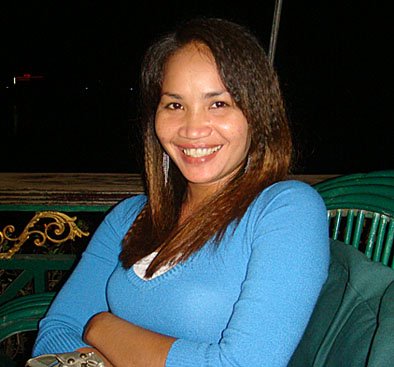 Postscript: I left a wet Phnom Penh and arrived in humid Vientiane at 5pm today. The refined old-world elegance of the Settha Palace Hotel is my home for tonight before an early flight to Luang Namtha in the morning. We took advantage of the hotel's gorgeously cool pool prior to a walk along the promenade facing the Mekong River and dinner, albeit disappointing fare at cheap prices, at the popular Khop Chai Deu restaurant.
Postscript: I left a wet Phnom Penh and arrived in humid Vientiane at 5pm today. The refined old-world elegance of the Settha Palace Hotel is my home for tonight before an early flight to Luang Namtha in the morning. We took advantage of the hotel's gorgeously cool pool prior to a walk along the promenade facing the Mekong River and dinner, albeit disappointing fare at cheap prices, at the popular Khop Chai Deu restaurant.
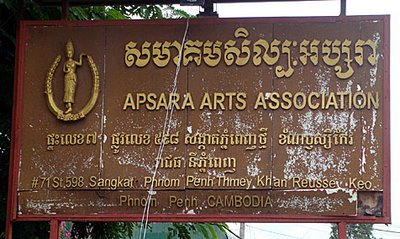 I visited Apsara Arts Association in Tuol Kork early this morning to watch the youngsters practicing their traditional Khmer classical dance in the wooden headquarters of the Phnom Penh-based NGO that provides free dance training for poor children from the age of four to late teens. Students can attend morning or evening classes according to their school schedules, so we saw just a few of the over 150 students students enrolled with the NGO, plying their skills. Funding remains an ever-present obstacle for the association explained Vong Metry, the vice-director and former classical dancer and teacher at the Royal University of Fine Arts. They host performances every Saturday night for the public but a lack of funds affects their ability to pay teachers and even to switch on the electricity, so beware that performances can be cancelled. The center also houses twenty children who are orphans and in vulnerable circumstances and ensures they receive a place to live, eat, go to school and of course, learn to dance or play music. Get along to the Apsara HQ if you have some spare time in Phnom Penh, they'll be pleased to see you.
I visited Apsara Arts Association in Tuol Kork early this morning to watch the youngsters practicing their traditional Khmer classical dance in the wooden headquarters of the Phnom Penh-based NGO that provides free dance training for poor children from the age of four to late teens. Students can attend morning or evening classes according to their school schedules, so we saw just a few of the over 150 students students enrolled with the NGO, plying their skills. Funding remains an ever-present obstacle for the association explained Vong Metry, the vice-director and former classical dancer and teacher at the Royal University of Fine Arts. They host performances every Saturday night for the public but a lack of funds affects their ability to pay teachers and even to switch on the electricity, so beware that performances can be cancelled. The center also houses twenty children who are orphans and in vulnerable circumstances and ensures they receive a place to live, eat, go to school and of course, learn to dance or play music. Get along to the Apsara HQ if you have some spare time in Phnom Penh, they'll be pleased to see you.The Phnom Kulen Archaeological Project
Lying 30 km outside of Angkor Archaeological Park is the cool, leafy retreat of Phnom Kulen. Best known as a popular picnic spot and location of the exquisite riverbed carvings known as the River of 1000 Lingas, archaeology buffs might also be familiar with the mountain as the location of the Angkorian period Kulen ware pottery kilns. But farther up the mountain and deeper into the misty jungle lay dozens of archaeological sites ranging from towering brick prasats, to cave sites, to water features. Until recently there had been little research done on these sites, but the Phnom Kulen Archaeological Program, in collaboration with the Apsara National Authority and funded by the Archaeology & Development Foundation, has begun a three-year project aimed at excavating, mapping, conserving and maintaining these sites.
Project Director Jean-Baptiste Chevance first visited the sites on Phnom Kulen Mountain in 2000 but did not have the funding to being research until January 2008. In its first field season the project has focused on conservation and excavation around three brick temple sites: Prasat Thma Dap, Prasat Neak Ta and Prasat, Anlong Thom. “Excavation is one part of the conservation process. It allow us to know the nature of foundations, the exact size of each site and to propose a perimeter for protection,” says Chevance. “Excavating Neak Ta and specially Thma Dap gave [us] a lot of information about peripheral structures.” Prasat Thma Dap had been previously excavated in the early 20th century by French archaeologists, however Chevance wanted to revisit and expand the initial test pits. Appearing as a lone brick temple nestled in the thick jungle the recent excavation has revealed a large area of occupation immediately around the temple. There is a second laterite tower, a surrounding wall, a causeway going to the East, a gopura, and evidence for wooden architecture. There is also the impressive brick and stuccowork on the temple itself.
In addition to excavation at these sites the team is also working on creating a more detailed map of all archaeological sites on the mountain in order to identify other sites in more urgent need of conservation. Sites slated for research in upcoming field seasons such as Rong Chen pyramid and Poeng Tbal cave, have also been mapped in detail. Chevance explains that this comprehensive research is necessary “in order to have a better vision on the occupation of the mountain.” The mountain is believed to have been inhabited from the 8th century AD to the end of the Angkorian period. It was initially rumored to have been a capital during the Jayavarman II period and later became a popular location for hermits from the 11th to 13th centuries. Archaeological research will help clarify how the Angkorian people used the mountain.
Despite the close proximity to Angkor there are no immediate plans for tourism. The sites are difficult to access, requiring a bumpy ride through narrow muddy paths. Additionally there is omnipresent danger of landmines and UXOs. Chevance notes that at the 5 sites that were de-mined prior to fieldwork 4 had unexploded UXOs. Even with the danger and difficulty of doing archaeological research on Phnom Kulen, PKAP team is looking forward to continuing field seasons. The project’s work in mapping, excavating, and conserving the sites on Phnom Kulen promises to provide useful data for expanding the archaeological record of this period, as well as helping villagers and preserving a unique part of Cambodian history. Article posted courtesy of Alison In Cambodia.
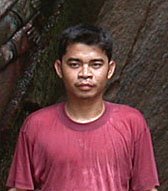 There are over 4,000 archaeological sites in Cambodia...and this man visited almost all of them. Here’s the latest article I wrote and submitted to TouchStone for publication in an upcoming issue: an interview with Chetra Chan. I met Chetra through a mutual archaeologist friend and am very impressed with all his archaeological experience so far. I’m glad to say he’ll be getting some more advanced GIS training in the US which I think will lead to some very exciting research in the future.
There are over 4,000 archaeological sites in Cambodia...and this man visited almost all of them. Here’s the latest article I wrote and submitted to TouchStone for publication in an upcoming issue: an interview with Chetra Chan. I met Chetra through a mutual archaeologist friend and am very impressed with all his archaeological experience so far. I’m glad to say he’ll be getting some more advanced GIS training in the US which I think will lead to some very exciting research in the future.Most tourists and visitors to Cambodia are only familiar with Cambodia’s major archaeological sites at the Angkor Archaeological Park in Siem Reap. However Cambodia is home to over 4000 archaeological sites all across the country, and one man, Chan Sovichetra, has visited almost all of them. Sovichetra, or Chetra to his friends, was a member of a joint project run by the Ministry of Culture and Fine Arts and the École française d’Extrême-Orient (EFEO), the goal of which was to map the location every archaeological site in Cambodia. Chetra joined the project in 2002 after finishing his degree in archaeology at the Royal University of Fine Arts in Phnom Penh. We asked Chetra about his experiences working on this project.
1. How did you go about finding out about all of these sites?
The first part of the project was to collect all the information that the French had already recorded. [Several French scholars including Etienne Aymonier and Lunet de Lajonquière surveyed and recorded archaeological sites in Cambodia the 19th century]. We would go out and visit these sites [to collect information for the maps]. For the second step, we collected information from the list documented by Department of Culture and Fine Arts for all the provinces. After that we would go to different villages and ask villagers about other sites nearby [that hadn’t yet been recorded]. We would take GPS points, photographs, and ask the villagers the name of the site.
2. How did you travel around the country to visit these sites? Were there any difficulties?
By motorbike. Sometimes the motorbike broke down which was difficult. Also I don’t know how to swim so I don’t like crossing rivers. But it was exciting. I am Cambodian so I enjoyed getting to see my country.
4. Were there any interesting artifacts at any of these sites? Could you tell how old they were?
Sometimes the sites were interesting and sometimes they weren’t. Most of them had already been destroyed. If there were temple remains I could sometimes look at that and determine the time period it was from. Almost all of the Angkorian period sites had evidence for pre-Angkorian occupation as well.
5. Were there any sites you were unable to go to visit?
Yes, there were many sites in areas with many landmines that we could not visit because it was too dangerous. There were many sites in Banteay Meanchey near the Thai border. These are not listed on the map.
6. What was your favorite place to visit? Is there any place you would like to go back and study more?
I really liked Preah Vihear. Not just the Preah Vihear temple, but there are many big temples in the province located in the dense jungle. I am also interested in the ancient roads. There is part of Angkorian road that goes near Bakan [also known as Preah Khan in Preah Vihear Province]. On the map it just stops but I think it goes further east, I would like to study that more.
7. What are your plans for the future?
I would like to continue studying archaeology. In July I will go to University of Hawaii to continue studying archaeology there for a special program to learn GIS and archaeology.
After six years of hard work and with additional help from UNESCO, a set of paper maps has been produced noting the names and locations of all of the recorded archaeological sites in Cambodia province by province. Maps have been published in both French and Khmer and are for sale at the National Museum and the French Cultural Center. A corresponding interactive website the Carte Interactive des Sites Archéologiques Khmers (CISARK) with photos and additional information can be found at: CISARK. Article printed courtesy of Alison In Cambodia.
 A new publication from Cornell University's Southeast Asian Program called At the Edge of the Forest: Essays on Cambodia, History, and Narrative in Honor of David Chandler is, as the title suggests, a book inspired by the work of the doyen of Cambodian scholars David Chandler and in particular his classic 1982 article, 'Songs at the Edge of the Forest,' and offers a series of essays on a wide range of subjects such as violence, wildness, and order, the "forest" and cultured
A new publication from Cornell University's Southeast Asian Program called At the Edge of the Forest: Essays on Cambodia, History, and Narrative in Honor of David Chandler is, as the title suggests, a book inspired by the work of the doyen of Cambodian scholars David Chandler and in particular his classic 1982 article, 'Songs at the Edge of the Forest,' and offers a series of essays on a wide range of subjects such as violence, wildness, and order, the "forest" and cultured 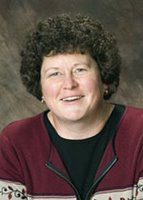 space, and the fraught "edge" where they meet. I think I need to read the book to understand that description! The book's editors are Anne Ruth Hansen (left) and Judy Ledgerwood (right), both professors in the United States and well-known for their work on Cambodian studies. In fact, they are working together on another book as I type, to be called Buddh Damnay: Buddhist Prophetic Histories of Violence in Cambodia. No date for that publication as yet. At the Edge of the Forest was published last month, and includes essays by Chandler himself, Penny Edwards, John Marston and others, is 251 pages in length and costs $23.95 in paperback.
space, and the fraught "edge" where they meet. I think I need to read the book to understand that description! The book's editors are Anne Ruth Hansen (left) and Judy Ledgerwood (right), both professors in the United States and well-known for their work on Cambodian studies. In fact, they are working together on another book as I type, to be called Buddh Damnay: Buddhist Prophetic Histories of Violence in Cambodia. No date for that publication as yet. At the Edge of the Forest was published last month, and includes essays by Chandler himself, Penny Edwards, John Marston and others, is 251 pages in length and costs $23.95 in paperback.
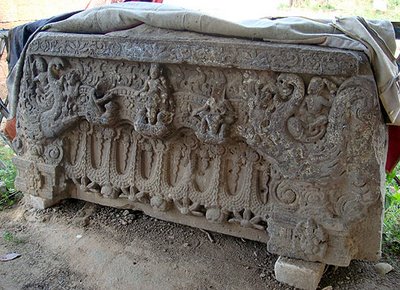 Sambor Prei Kuk style 7th century lintel from Wat Preah Theat, now with the National Museum for safekeeping
Sambor Prei Kuk style 7th century lintel from Wat Preah Theat, now with the National Museum for safekeeping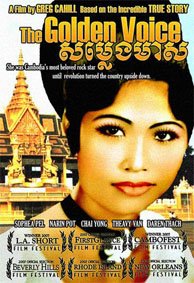 Don't forget this Saturday night's 7.30pm screening of The Golden Voice, a 25-minute short film by Greg Cahill, who will present his film and take part in a Q&A session after the screening, at the Meta House on Street 264 near Wat Botum in Phnom Penh. The film was a big hit when shown at the CamboFest last year and has been an ever-present at many of the film festivals in the United States ever since. Cahill's plans are to extend the film into a full-length movie bio of one of Cambodia's best-loved female singers Ros Sereysothea. As part of the vibrant rock n' roll scene that flourished in Cambodia during the 1960s, Ros Sereysothea was dubbed 'the golden voice of the royal capital' by Prince Sihanouk. As her career soared to an unprecedented level of success, Phnom Penh and Cambodia fell to the Khmer Rouge regime and artists and intellectuals were targeted for execution - could Cambodia's most famous star avoid detection? - find out on Saturday.
Don't forget this Saturday night's 7.30pm screening of The Golden Voice, a 25-minute short film by Greg Cahill, who will present his film and take part in a Q&A session after the screening, at the Meta House on Street 264 near Wat Botum in Phnom Penh. The film was a big hit when shown at the CamboFest last year and has been an ever-present at many of the film festivals in the United States ever since. Cahill's plans are to extend the film into a full-length movie bio of one of Cambodia's best-loved female singers Ros Sereysothea. As part of the vibrant rock n' roll scene that flourished in Cambodia during the 1960s, Ros Sereysothea was dubbed 'the golden voice of the royal capital' by Prince Sihanouk. As her career soared to an unprecedented level of success, Phnom Penh and Cambodia fell to the Khmer Rouge regime and artists and intellectuals were targeted for execution - could Cambodia's most famous star avoid detection? - find out on Saturday.
 You've seen her before, in a previous posting on my visit to Oudong. Her name is Panmai. As I ate lunch at the base of Oudong mountain, there was simply too much for me to eat so I shared my roast chicken with three youngsters and an elderly lady. Panmai's appetite was voracious, and she tucked into the food without reservation, whilst her two friends, Phirum and Sophea weren't far behind. Both of the boys later acted as my guides for my stupa-visiting on the mountaintop, whilst Panmai was far more sensible and carried on selling her colourful bracelets amongst the shade of the eating huts. I saw her again before I left the mountain and bought her a sugar cane drink as a parting gift. Lovely kid.
You've seen her before, in a previous posting on my visit to Oudong. Her name is Panmai. As I ate lunch at the base of Oudong mountain, there was simply too much for me to eat so I shared my roast chicken with three youngsters and an elderly lady. Panmai's appetite was voracious, and she tucked into the food without reservation, whilst her two friends, Phirum and Sophea weren't far behind. Both of the boys later acted as my guides for my stupa-visiting on the mountaintop, whilst Panmai was far more sensible and carried on selling her colourful bracelets amongst the shade of the eating huts. I saw her again before I left the mountain and bought her a sugar cane drink as a parting gift. Lovely kid. The 'Smile of Angkor' has captured the imagination of visitors for centuries. Each face is distinquished by; a broad forehead, downcast eyes, wide nostrils, thick lips curling upwards at the corners and a hint of a moustache. This is Pierre Loti's reaction when he saw the faces of the Bayon, taken from his 1902 book, Siam:
The 'Smile of Angkor' has captured the imagination of visitors for centuries. Each face is distinquished by; a broad forehead, downcast eyes, wide nostrils, thick lips curling upwards at the corners and a hint of a moustache. This is Pierre Loti's reaction when he saw the faces of the Bayon, taken from his 1902 book, Siam: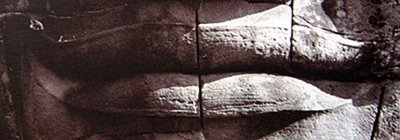 This extract and many more in a similar vein can be found in a book by the author Dawn Rooney, called Angkor Observed, which was published by Orchid Press in 2001. It consists of a selection of early travellers' impressions of Angkor, most of which are out-of-print and found only in the archives of institutions or specialized libraries, so few people today know about the experiences and thoughts of these early visitors to Angkor. It's a fascinating guidebook companion to Angkor.
This extract and many more in a similar vein can be found in a book by the author Dawn Rooney, called Angkor Observed, which was published by Orchid Press in 2001. It consists of a selection of early travellers' impressions of Angkor, most of which are out-of-print and found only in the archives of institutions or specialized libraries, so few people today know about the experiences and thoughts of these early visitors to Angkor. It's a fascinating guidebook companion to Angkor.
As we sip beers under the whirring fans of the Foreign Correspondents Club and look out over Phnom Penh, it is hard to imagine that in 1975 this entire city was evacuated and the population moved into enforced labour camps in the countryside. While Vietnam remains poor, it has had several decades to clear away the debris of war and build up a thriving tourist industry. In neighbouring Cambodia, violence and bloodshed stopped only in the past 10 years or so. Pol Pot's Khmer Rouge were still operating as a guerrilla movement well into the 1990s.
With the Khmer Rouge now disbanded and a relatively stable government in place, the country has done an impressive job of plastering over the tragedy and unrest of its recent past. Phnom Penh is full of bustling street-cafes and tourists in rickshaws visiting the glittering royal palace. The people are charming and friendly but behind the facade the country's scars are still there. The Killing Fields are now gruesome tourist destinations and Toul Sleng prison, a former school that became a place of torture and death under the Khmer Rouge, is now a museum. It's a chilling and deeply moving place with hundreds of haunting photographs of the victims hanging on the walls. Everyone you meet has their own story. Our tour guide cheerily tells us his extraordinary tale of life under the Khmer Rouge and it's as gripping as any Hollywood thriller. We're so enthralled we send the taxi round the block a few times until he's finished.
We had hoped to take a boat up the Mekong river to Siem Reap but the water level is too low so it has to be a short aeroplane flight. At Siem Reap we are picked up from the airport in a vintage stretch Mercedes that used to belong to King Sihanouk. Left to rust during the Khmer Rouge period, it was rescued by the owners of our hotel, Amansara, which was formerly the king's residence: he entertained the likes of Jackie O here in the 1960s. Under Pol Pot it became a weapons dump and was left to ruin. Now it's been restored to its former glory and is the very model of elegant 1960s designer chic. Private butler, private plunge-pool, free cakes and mini-bar - outrageous luxury and our home while we visit nearby Angkor Wat. No words can do justice to the beauty of the vast 12th-century temples so I won't even try. Just look at the pictures. And try not to be too distracted by my amazing hat.
Tourists flock to these temple complexes, so we get up at 6am and spend an hour or so exploring them with only a blissful soundtrack of local wildlife. I am terrified of getting bitten by a mosquito because my mum says I will get malaria and die. I cover myself in a thick sheen of insect repellent. I want to bring a mosquito net with me from the hotel but Claire says it will look silly with my hat. As other tourists start to arrive, we venture down a jungle pathway and 20 minutes later find Ta Nei, a smaller temple rarely bothered by visitors. It's private and beautiful. I need a wee. I am about to go behind a tree when my guide reminds me that there are still between 4 million and 6 million unexploded land mines in Cambodia and I should be careful where I tread. I hold it in.
Next day we take a boat ride on Tonle Sap lake and stare at the families of fishermen who live on the water in floating villages. This makes me feel guilty again. I am peering at poor people like they're animals in a zoo. I am disgusted with myself so I make sure I've got enough photos and then ask the boatman to take us back. This is the agony of holidaying in developing countries. Some say you are bringing welcome cash into the economy, others that you are exploiting the impoverished locals. Have I seen the real Vietnam and Cambodia? I haven't ventured off the tourist trail, so not really, but if you're like me and you want to see far-flung places without getting your hands dirty, it can be done, and in great style and safety. And even if I wasn't very adventurous, one evening after dinner I did utter the words: 'Hmm, I think that gekko is repeating on me.' Now you can't say that after two weeks in Devon.
 The yellow stupa with its spire topped by four faces belongs to King Monivong (died 1941) and is called Chet Dey Mak Proum
The yellow stupa with its spire topped by four faces belongs to King Monivong (died 1941) and is called Chet Dey Mak Proum Hot off the press.... there will be a premiere screening of Rain Falls From Earth at the Meta House in Phnom Penh on Saturday 9 August, so the film's director, Steve McClure told me by email today. Mark it in your calendar. The film is appearing at a bunch of film festivals in the States right now and when McClure returns to Cambodia in a couple of months, he'll bring a copy of his documentary with him - even though he hasn't yet completed shooting.
Hot off the press.... there will be a premiere screening of Rain Falls From Earth at the Meta House in Phnom Penh on Saturday 9 August, so the film's director, Steve McClure told me by email today. Mark it in your calendar. The film is appearing at a bunch of film festivals in the States right now and when McClure returns to Cambodia in a couple of months, he'll bring a copy of his documentary with him - even though he hasn't yet completed shooting.In the wake of the Vietnam War and not far from it, one of the greatest tragedies the world has ever seen took place. To this day, it seems that relatively few Americans know about it. "I basically knew nothing about it. I barely knew where Cambodia was," said filmmaker Steve McClure, recalling when he first began to read about the tyrannical Khmer Rouge regime that killed an estimated 2 million Cambodians in the late 1970s. "I started doing some research about how this massive event in history happened, and really no one knew that it happened. "I just started finding (survivors) through the Internet and was just intrigued by their stories. I thought this would really be a good subject to tackle." McClure's curiosity spawned the film "Rain Falls From Earth," which chronicles the personal accounts of eight Khmer Rouge survivors and their tale of struggle and perseverance in one of history's darkest hours.
In one of the highlights of this weekend's International San Joaquin Film Festival, McClure will be on hand Sunday to discuss the film after a screening at University of the Pacific's Faye Spanos Concert Hall. One of the survivors also will be in attendance. "If they told you that rain falls from Earth, you agreed or would be killed for being an intellectual," goes the tagline for the movie that took McClure on two personally enlightening journeys to Cambodia, where he talked not only with Khmer Rouge survivors, but also members of the regime itself. "We visited an entire village of former Khmer Rouge," he said. "We interviewed three former members that are in the film. It was very eerie. It was a throwback to the '70s. They live like nothing ever happened; they all seem to be in denial. "I liked having that perspective on it," McClure added. "I let them tell their own story just like I let the survivors tell their story. I didn't judge them. I just asked them questions about what they did and what they saw."
McClure hopes to return to Cambodia in the near future to gather more footage for "Rain Falls From Earth," which is narrated by Sam Waterston, the star of the only Hollywood exploration of the tragedy, 1984's "The Killing Fields." "It seems like the first question out of everyone's mouth is, 'Why are you doing this?' " McClure said. "I think if I can talk about my interests and how these people and this film touched me, that's an insight that people want to know. People can say, 'You're a white guy living in America. Why do you care?' But it's just built over time; it's this passion that takes you over."
 It's vitally important, in my view, that shows such as those being staged at the Chenla Theater tomorrow and Sunday get the audience numbers they deserve. In this case, Amrita Performing Arts and the dancers from the School of Fine Arts are putting on a newly revived performance of Khmer Classical Dance - called Preah Anurudh Preah Neang Ossa - and new pieces like these are pretty rare, so the time and effort taken in staging these shows should be rewarded. Tickets are a snip at 3,000 and 6,000 riel, performances on both days begin at 6pm and will be accompanied by a traditional pinpeat orchestra, singers and narration. I was lucky enough to see the premiere of this new work at a special staging of the dance in February and its well worth going to see. Kudos to ANZ Royal Bank for sponsoring this event.
It's vitally important, in my view, that shows such as those being staged at the Chenla Theater tomorrow and Sunday get the audience numbers they deserve. In this case, Amrita Performing Arts and the dancers from the School of Fine Arts are putting on a newly revived performance of Khmer Classical Dance - called Preah Anurudh Preah Neang Ossa - and new pieces like these are pretty rare, so the time and effort taken in staging these shows should be rewarded. Tickets are a snip at 3,000 and 6,000 riel, performances on both days begin at 6pm and will be accompanied by a traditional pinpeat orchestra, singers and narration. I was lucky enough to see the premiere of this new work at a special staging of the dance in February and its well worth going to see. Kudos to ANZ Royal Bank for sponsoring this event.
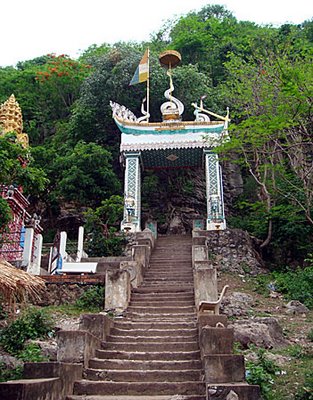 The entrance to Phnom Sampeou, 1,225 steps and the archway showing the ship from the story of Rumsay Sok
The entrance to Phnom Sampeou, 1,225 steps and the archway showing the ship from the story of Rumsay Sok